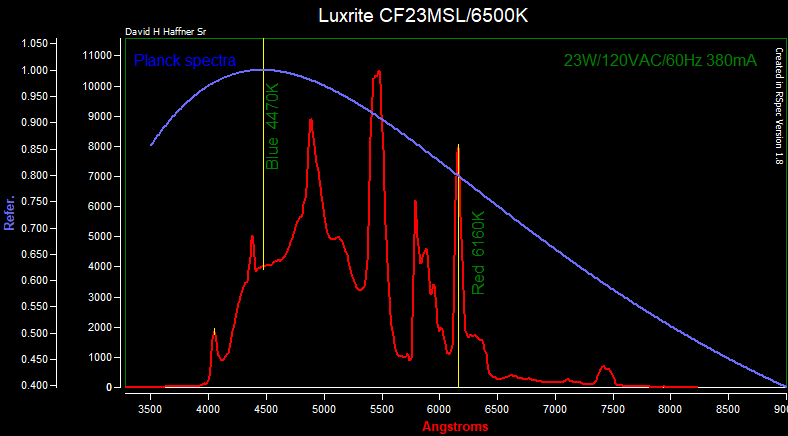@Ted Yapo he wanted to know; "Can you verify/estimate that this spectrum is close to a 6500K color temperature?"
And the answer is yes, in RSpec I just figured it out, so I'll just get right to it and then explain the concepts behind it afterwards.

Ok, there's a lot going on here, 1st is the Planck's spectral blue line, which is our "black body," this is our reference spectra @ 6500k. My CFL lamp has been calibrated to this reference and is accurate because my spectrometer has already been calibrated for instrument response.
To the far left you see the 2nd Y axis Refer. This is our ratio between red and blue light, because blue is our shorter wavelength which are hotter and red are longer wavelengths which are much cooler. Since we can use the computer to do the math we can use wavelength's as our measurements instead of blue and red filters.
We convert Angstroms to Nanometers and get 447nm for blue and 616nm for red, these are the calibration points. The program already did the calculations and found the ratio to be 1.050 but on my calculator I got 1.055? The difference between 6500k and 6160.
This is not written in stone mind you, but is still accurate because the temperature of any bulb will change somewhat ( called "drift") over time. just like the Sun does, it's temp (surface,) is around 5400K but changes because of many variables.

Above are both my 2300k and 6500k CFL bulbs, I didn't bother calculating the 2300k bulb as I felt it was irrelevant. Still a good comparison since both are at the same intensity. You notice the 6500k CFL's blue zone is much hotter than the 2300k's CFL. That's the manufacturer trying to simulate daylight...Ha!
Not that I'm giving a shameless plug to the Solux company, but their Halogen bulbs are far superior in these regards.
I hope this helped answer your question Ted, and anyone else out here that is interested in this subject :)
 David H Haffner Sr
David H Haffner Sr
Discussions
Become a Hackaday.io Member
Create an account to leave a comment. Already have an account? Log In.
Nice!
So, the color temperature of these lamps is determined from two narrow spectrum measurements? That's really interesting. I would have imagined some other way, similar to comparing probability distributions. It does explain some of the lousy bulbs out there! I asuume the halogen bulb you mention is much better because it really does have a blackbody distribution?
Are you sure? yes | no
Hey Ted, ah yes, the Solux lamp, my favorite, it is the closest you'll get to a real broad band spectrum without having to spend about 5K on a lab grade certified one. The one I have is a 50W 12VDC 1.2A 4700K, ( cost is about $200.00 US) which if you know what UR doing with it can produce "almost" the same thing :)
Are you sure? yes | no